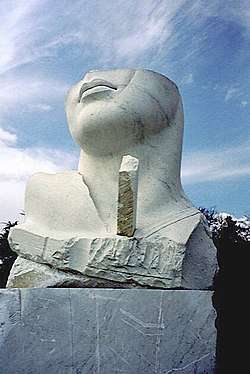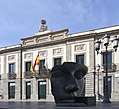Igor Mitoraj
Igor Mitoraj (26 March 1944 – 6 October 2014) was a Polish artist and sculptor.[1] Known for his fragmented sculptures of the human body often created for large-scale public installations, he is considered one of the most internationally recognized Polish sculptors.[2][3]
Igor Mitoraj | |
|---|---|
.jpg) Mitoraj in 2014 | |
| Born | 26 March 1944 |
| Died | 6 October 2014 (aged 70) |
| Nationality | Polish |
| Education | Kraków Academy of Art |
| Known for | Sculptor |
Notable work | Luci di Nara Eros Bendato Héros de Lumière |

Biography
Mitoraj was born on 26 March 1944 in Oederan, Germany. His Polish mother was a forced labourer, while his father was a French officer of Polish extraction.[4][5] He returned with his mother to Poland after the end of World War II. He spent his childhood years in Grojec. He graduated from an art school in Bielsko-Biała and in 1963 he studied painting at the Kraków Academy of Art under Tadeusz Kantor. After graduating, he had several joint exhibitions, and held his first solo exhibition in 1967 at the Krzysztofory Gallery in Poland. In 1968, he moved to Paris to continue his studies at the National School of Art.
Shortly afterwards, he became fascinated by Latin American art and culture, spending a year painting and travelling around Mexico. The experience led him to take up sculpture.
He returned to Paris in 1974 and two years later he held another major solo exhibition at the Gallery La Hune, including some sculptural work. The success of the show persuaded him that he was first and foremost a sculptor.
Having previously worked with terracotta and bronze, a trip to Carrara, Italy, in 1979 turned him to using marble as his primary medium and in 1983 he set up a studio in Pietrasanta. In 2006, he created the new bronze doors and a statue of John the Baptist for the basilica of Santa Maria degli Angeli in Rome.
In 2003 he returned to Poland.
In 2005 he received the Golden Medal of Medal for Merit to Culture - Gloria Artis[6] 2012 he received the Commander's Cross of the Order of Polonia Restituta.[7]
Style
Mitoraj's sculptural style is rooted in the classical tradition with its focus on the well modelled torso. However, Mitoraj introduced a post-modern twist with ostentatiously truncated limbs, emphasising the damage sustained by most genuine classical sculptures. Often his works aim to address the questions of human body, its beauty and fragility, its suffering as well as deeper aspects of human nature, which as a result of the passing of time undergo degeneration.[8]
Gallery

 Gambe Alate (bronze), 2002, exhibition in Kraków, Poland, 2003 r.
Gambe Alate (bronze), 2002, exhibition in Kraków, Poland, 2003 r.

 Luci di Nara, at the main entrance of the British Museum in 2002.
Luci di Nara, at the main entrance of the British Museum in 2002. Centurione I, 1987, Bamberg, Germany.
Centurione I, 1987, Bamberg, Germany.- Centurione III, 1992, Regensburg, Germany.
 Igor Mitoraj Exhibition, Barcelona, Spain.
Igor Mitoraj Exhibition, Barcelona, Spain. Half Face, Castle Square, Warsaw, Poland.
Half Face, Castle Square, Warsaw, Poland. Per Adriano, Santa Cruz de Tenerife, Spain.
Per Adriano, Santa Cruz de Tenerife, Spain. Centauro, Canary Wharf, London, Great Britain.
Centauro, Canary Wharf, London, Great Britain. Icarus in front of Temple of Concordia in the Valley of the Temples, Agrigento, Italy.
Icarus in front of Temple of Concordia in the Valley of the Temples, Agrigento, Italy..jpg) "Eros Bendato" on Main Square, Kraków
"Eros Bendato" on Main Square, Kraków
References
- "Igor Mitoraj obituary". The Guardian. 17 October 2014.
- "Igor Mitoraj". Retrieved 2020-05-06.
- "Igor Mitoraj". Retrieved 2020-05-06.
- Mitoraj, the spell of Gorgon. National Museum, Warsaw. 2003. p. 10. ISBN 978-83-88848-0-63.
- Paltenghi, Barbara; Chiappini, Rudy (2002). Igor Mitoraj. Skira. p. 124.
- wiadomości.wp.pl (2005-10-05). "Medal Gloria Artis dla twórców i działaczy kultury - Wiadomości - WP.PL". Wiadomosci.wp.pl. Archived from the original on 2013-10-03. Retrieved 2013-05-28.
- "Odznaczenia z okazji Święta 3 Maja / Ordery i odznaczenia / Aktualności / Oficjalna strona Prezydenta Rzeczypospolitej Polskiej". Prezydent.pl. Archived from the original on 2013-09-13. Retrieved 2013-05-28.
- "With his mammoth sculptures of fragmented bodies expressing human suffering, Igor Mitoraj was in a class of his own". Retrieved 2019-09-21.
External links
| Wikimedia Commons has media related to Igor Mitoraj. |
- Emociones da Trajano. Video by Leandro Manuel Emede shot in Roma at Mercati di Traiano
- more pics of Mitoraj's sculptures
- (in Polish) Igor Mitoraj. Rzeźba i rysunek
- "Eros Tied in Krakow". Cracovia. October 2005. Archived from the original on October 21, 2007.
- Contini Art UK
- Igor Mitoraj at Art Gallery Katarzyna Napiórkowska in Poland